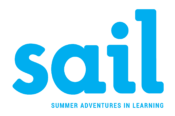The Story of SAIL
♦ Children regress when they don’t practice their academic skills over the summer. This is known as 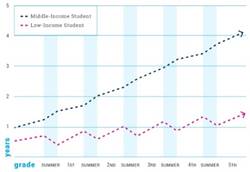 summer learning loss, or the summer slide. Children from low-income families lose two-three months of grade equivalency in both math and reading every summer, year after year. The loss is cumulative; the gap grows over time.
summer learning loss, or the summer slide. Children from low-income families lose two-three months of grade equivalency in both math and reading every summer, year after year. The loss is cumulative; the gap grows over time.
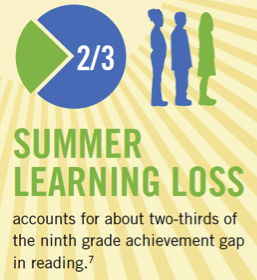
♦ A study by Johns Hopkins University measured the gap in reading as three years at the end of the ninth grade. They found that 2/3 of the gap was attributable to summer learning loss. Further, they found that summer learning loss was the primary driver of later problems; failure to graduate, attend college, and successfully enter the workforce. To see the Research Brief, click here.
♦ Children from under-served communities face other challenges over the summer as well; many do not eat well, do not exercise, and lack a safe environment that is free from harmful influences. Parents consistently cite summer as the most difficult time to ensure that their children have productive things to do.
♦ SAIL programs nurture the whole child: our students grow in mind, body and spirit. Programs start with a foundation of rigorous instruction (in reading, literacy, and math) and build from there. 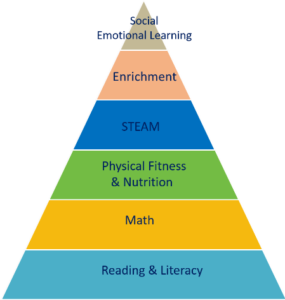 SAIL programs incorporate best practices from summer camp and school, so students learn as they have fun. They come to understand that learning is fun!
SAIL programs incorporate best practices from summer camp and school, so students learn as they have fun. They come to understand that learning is fun!
♦ Building programs that incorporate best practices from both schools and summer camps presents a challenge; few organizations have experience in both. SAIL meets this challenge by brin ging together the community! Youth organizations, faith-based organizations, philanthropy, community groups, municipal agencies, and schools pool their knowledge and resources to create programs better than any of them could have created alone.
ging together the community! Youth organizations, faith-based organizations, philanthropy, community groups, municipal agencies, and schools pool their knowledge and resources to create programs better than any of them could have created alone.
♦ SAIL funders conduct a common grant cycle to streamline the funding process. Programs submit only one grant application f or all funders to review; and submit only one report at the end of the summer.
or all funders to review; and submit only one report at the end of the summer.
♦ SAIL uses Renaissance Learning Systems Star Assessments for reading and math:
→ Pre-test results inform instruction and enable individualized learning strategies.
→ End-of-program results measure student growth and highlight opportunities for programs to improve over time.
♦ End-of-summer reports are shared to show each program’s trends and how it compares to its peers. Our programs use our data to grow stronger together.
♦ S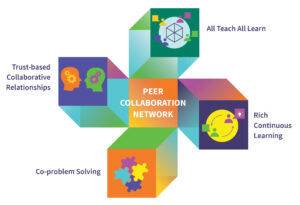 AIL understands that the group knows far more collectively than any single member alone. Our programs share their expertise to help one another grow stronger. This is known as peer learning.
AIL understands that the group knows far more collectively than any single member alone. Our programs share their expertise to help one another grow stronger. This is known as peer learning.
SAIL HAS HELPED OVER 21,700 ALABAMA CHILDREN PREPARE FOR SUCCESSFUL LIVES!
| SAIL programs use research-based curriculum, certified teachers, and Star Assessments to drive academic growth. | |
| AVERAGE GAIN PER STUDENT | |
| Reading: 1.7 months | Math: 2.6 months |
AVERAGE IMPACT PER STUDENT (Considering the “summer slide” of 2+ months loss for low-income students) | |
| Reading: about 4 months | Math: about 5 months |
SAIL IS COST EFFECTIVE The average cost of a SAIL academic program is around $1,000 per child. When the high academic gains are factored with the reasonable cost, the value of SAIL programs is evident! | SAIL REACHES UNDER-SERVED COMMUNITIES In SAIL programs:
|
For a full discussion, visit Outcomes.
